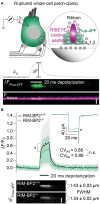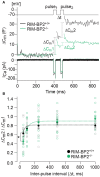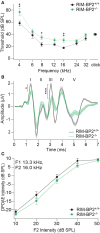RIM-Binding Protein 2 Promotes a Large Number of CaV1.3 Ca2+-Channels and Contributes to Fast Synaptic Vesicle Replenishment at Hair Cell Active Zones
- PMID: 29163046
- PMCID: PMC5673845
- DOI: 10.3389/fncel.2017.00334
RIM-Binding Protein 2 Promotes a Large Number of CaV1.3 Ca2+-Channels and Contributes to Fast Synaptic Vesicle Replenishment at Hair Cell Active Zones
Abstract
Ribbon synapses of inner hair cells (IHCs) mediate high rates of synchronous exocytosis to indefatigably track the stimulating sound with sub-millisecond precision. The sophisticated molecular machinery of the inner hair cell active zone realizes this impressive performance by enabling a large number of synaptic voltage-gated CaV1.3 Ca2+-channels, their tight coupling to synaptic vesicles (SVs) and fast replenishment of fusion competent SVs. Here we studied the role of RIM-binding protein 2 (RIM-BP2)-a multidomain cytomatrix protein known to directly interact with Rab3 interacting molecules (RIMs), bassoon and CaV1.3-that is present at the inner hair cell active zones. We combined confocal and stimulated emission depletion (STED) immunofluorescence microscopy, electron tomography, patch-clamp and confocal Ca2+-imaging, as well as auditory systems physiology to explore the morphological and functional effects of genetic RIM-BP2 disruption in constitutive RIM-BP2 knockout mice. We found that RIM-BP2 (1) positively regulates the number of synaptic CaV1.3 channels and thereby facilitates synaptic vesicle release and (2) supports fast synaptic vesicle recruitment after readily releasable pool (RRP) depletion. However, Ca2+-influx-exocytosis coupling seemed unaltered for readily releasable SVs. Recordings of auditory brainstem responses (ABR) and of single auditory nerve fiber firing showed that RIM-BP2 disruption results in a mild deficit of synaptic sound encoding.
Keywords: RIM-BP; STED microscopy; calcium; cochlea; electron microscopy; exocytosis; ribbon synapse.
Figures












Similar articles
-
RIM-Binding Protein 2 Organizes Ca2+ Channel Topography and Regulates Release Probability and Vesicle Replenishment at a Fast Central Synapse.J Neurosci. 2021 Sep 15;41(37):7742-7767. doi: 10.1523/JNEUROSCI.0586-21.2021. Epub 2021 Aug 5. J Neurosci. 2021. PMID: 34353898 Free PMC article.
-
RIM-Binding Proteins Are Required for Normal Sound-Encoding at Afferent Inner Hair Cell Synapses.Front Mol Neurosci. 2021 Mar 23;14:651935. doi: 10.3389/fnmol.2021.651935. eCollection 2021. Front Mol Neurosci. 2021. PMID: 33867935 Free PMC article.
-
Rab3-interacting molecules 2α and 2β promote the abundance of voltage-gated CaV1.3 Ca2+ channels at hair cell active zones.Proc Natl Acad Sci U S A. 2015 Jun 16;112(24):E3141-9. doi: 10.1073/pnas.1417207112. Epub 2015 Jun 1. Proc Natl Acad Sci U S A. 2015. PMID: 26034270 Free PMC article.
-
New insights into cochlear sound encoding.F1000Res. 2016 Aug 26;5:F1000 Faculty Rev-2081. doi: 10.12688/f1000research.8924.1. eCollection 2016. F1000Res. 2016. PMID: 27635230 Free PMC article. Review.
-
Resolving the structure of inner ear ribbon synapses with STED microscopy.Synapse. 2015 May;69(5):242-55. doi: 10.1002/syn.21812. Epub 2015 Mar 11. Synapse. 2015. PMID: 25682928 Review.
Cited by
-
A Consolidated Understanding of the Contribution of Redox Dysregulation in the Development of Hearing Impairment.Antioxidants (Basel). 2024 May 13;13(5):598. doi: 10.3390/antiox13050598. Antioxidants (Basel). 2024. PMID: 38790703 Free PMC article. Review.
-
TCF4 mutations disrupt synaptic function through dysregulation of RIMBP2 in patient-derived cortical neurons.bioRxiv [Preprint]. 2023 Jan 20:2023.01.19.524788. doi: 10.1101/2023.01.19.524788. bioRxiv. 2023. Update in: Biol Psychiatry. 2024 Apr 1;95(7):662-675. doi: 10.1016/j.biopsych.2023.07.021. PMID: 36712024 Free PMC article. Updated. Preprint.
-
Differences in Calcium Clearance at Inner Hair Cell Active Zones May Underlie the Difference in Susceptibility to Noise-Induced Cochlea Synaptopathy of C57BL/6J and CBA/CaJ Mice.Front Cell Dev Biol. 2021 Feb 5;8:635201. doi: 10.3389/fcell.2020.635201. eCollection 2020. Front Cell Dev Biol. 2021. PMID: 33634111 Free PMC article.
-
The Effects of Aging on Rod Bipolar Cell Ribbon Synapses.Cells. 2023 Sep 29;12(19):2385. doi: 10.3390/cells12192385. Cells. 2023. PMID: 37830599 Free PMC article.
-
Nanomachinery Organizing Release at Neuronal and Ribbon Synapses.Int J Mol Sci. 2019 Apr 30;20(9):2147. doi: 10.3390/ijms20092147. Int J Mol Sci. 2019. PMID: 31052288 Free PMC article. Review.
References
LinkOut - more resources
Full Text Sources
Other Literature Sources
Molecular Biology Databases
Miscellaneous

